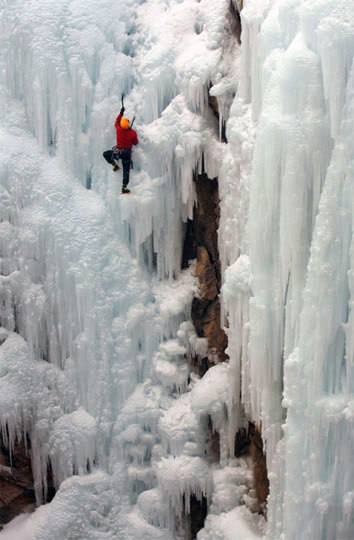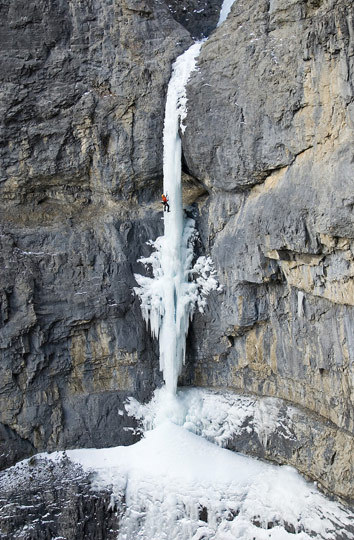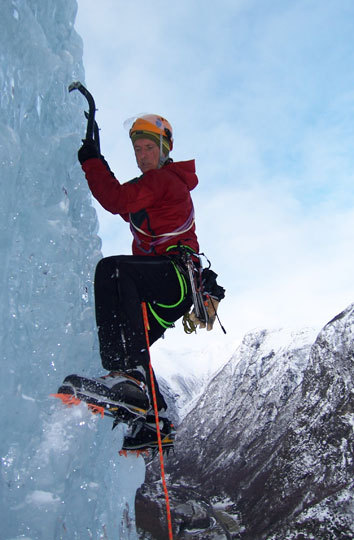Guy Lacelle died in an avalanche on December 10, 2009. Find Alpinist’s video tribute to Guy in the December 23, 2009 Feature.
Soloing is often described as the most pure and dangerous form of climbing. For all of us, testing the limit of what’s comfortable, whether that is scrambling up 5.3 terrain or spending fifty days on a big wall alone, is an unparalleled mental and physical exploration.

Guy Lacelle ice climbing in Ouray, Colorado. [Photo] John Evans www.johnevansphoto.com
We at Alpinist asked the most inspiring solo climbers we know–those defining the edge of what’s humanly possible–to tell us more about their rare connection to the vertical world.
After exploring the minds of rock master Alex Honnold and big wall diva Silvia Vidal, the Solo Series delves into the world of ice climbing with Guy Lacelle. Guy has likely soloed more pitches than most could ever dream to climb in a lifetime. Discover below how Guy’s perspective has evolved and what has kept him safe since he first started soloing nearly thirty years ago.
1. Please tell us a bit about yourself.
I live in Prince George B.C. and work in silviculture. I started climbing in the late 1970s, rock first then ice.
2. How did you start ice climbing? How many years have you been ice climbing?
I started rock climbing in Quebec on an outdoor course with the University of Ottawa. I started ice climbing on a course with La Federation Quebecoise de la Montagne.
3. Please describe what it was like to ice climb in the ’70s.
Putting in protection was the most difficult part of ice climbing, especially in the cold ice of Quebec. Stopping to put pro on steep ice was exhausting. I quickly started running out the steep sections and put gear only on ledges. I felt comfortable running out the steep sections and progressed rapidly to free soloing.
4. Ice gear has changed significantly over the past ten years. How does the evolution of the gear influence your free soloing? Do you free solo with or without leashes?
At first, when I started climbing, leashless. I thought I would be going back to most of the climbs I had already soloed and solo them leashless. I felt good on climbs like Polar Circus, but on long vertical climbs, I did not feel nearly as secure as I did with leashes. I realized I was closing in on the margin of safety. Now I don’t put any more pressure on myself and use leashes whenever I need the extra margin of safety.
5. Do you only free solo ice, or do you free solo rock and alpine climbs as well? Which medium do you feel most comfortable on?
On rock I only solo moderate routes. I am not as talented on rock, and I don’t climb it nearly as much as ice. Rock climbing is more diversified and requires more mileage to have the ability to solo near your maximum ability.
6. When did you start free soloing? What motivated you do it?
After a couple of seasons, I started to solo both rock and ice. It has always felt to me like the most natural way to climb. I get more satisfaction in the flow of movement without having to deal with all the gear, especially on ice. I like to have full responsibility for my actions.

Guy soloing Fearful Symmetry (WI6) in December, 2006. [Photo] Andrew Querner www.restless-planet.com
7. Do you do as much free soloing now as you did when you started?
I don’t solo as much now, but I still do it quite a bit. I have more experience and technique now, which allows me to have a better margin of safety as long as I am still aware of my vulnerabilities. I don’t get into difficult situations as often as I used to.
8. Does soloing define you as a climber?
I guess in a way it does define me as a climber. My best abilities are solicited when soloing. It is the activity that I am the most suited for physically and especially mentally.
9. How do you decide to solo a route? Do you onsight solo ice routes?
Sometimes I solo them onsight, but if the ice conditions are marginal, I will sometimes climb the route before to see if it is a feasible climb to free solo.
10. Can you define in one word what need you are trying to satisfy when free soloing?
Freedom– in the sense that the greatest satisfaction from climbing comes when there is nothing that comes between me and the climb and all my focus all my physical abilities are used to get up the climb safely. For how long is hard to say, but it lasts longer now in my fifties than in my early days.

[Photo] Chris Alstrin collection
11. What does soloing bring to your daily life?
Basically it satisfies a need deep inside of me that cannot be solicited in any other way. It helps me feel more confident in my daily life.
12. Ice is an ephemeral and brittle medium. How does this affect your free solo climbing?
After all these years, I can usually read the ice quite well, and it is very rare that I am not confident with my tool placements, but still I have to be very careful and expect the unexpected because overconfidence can kill you very quickly. As far as exposure to daggers and avalanches, I do my best to chose the right time to do a climb and choose the least exposed line. Then luck comes into play, same as driving a car I guess.
13. How do you stop fear from controlling you?
Most of the fear and doubts happen before I start the climb, not on the climb. Controlling fear and doubts comes in part from natural makeup and in part from mileage. It seems when something wrong happens and things get dicey I can focus all my abilities on doing the right thing to get me out of the situation. It might mean I keep going with a less-than-secure placement to save enough energy– as opposed to getting secure placements until I run out of energy and fall. I am thankful this situation has not happened for many years now.
14. In 1997, you did the first free solo link up of three WI5/6 climbs on the very exposed Trophy Wall on Mount Rundle in Canada: Sea of Vapors, Terminator and the Replicant. How do you deal with the exposure and the fatigue on such a link up?
I didn’t put any pressure on myself. I started with Replicant to warm up, then I felt good and climbed the most demanding route, Terminator, and finally felt like I had enough energy left to climb Sea of Vapor safely. It took me five hours, which is about the maximum amount of time for me before my focus and energy start to diminish. As for as the exposure, it helps me to stay focused but doesn’t wear on my energy. I have been more taxed on a few occasions than the Trophy Wall day. For example linking Weeping Pillar and Polar Circus in twelve hours in December with brittle ice and less training.

[Photo] Chris Alstrin collection
15. What was your scariest moment on a free solo climb?
During the early 1990s I tried the first free solo ascent (as far as I know) of Nemesis. The climb was going to push me close to my limit without any incident. On the steepest section of the climb the ice got very thin and brittle. I started getting stressed and tired. As my forearms got pumped, I didn’t feel my placements very well and broke a pick. When I swung the other tool harder, I bent that one. I was too pumped to pull my third tool, which was stuck in my hostler. When I realized that a fall was imminent, I decided to keep climbing fairly quickly on marginal placements as a last alternative, and it worked. When I reached a rappel stance and contemplated if I should continue climbing using the third tool I realized that I had already failed whether I reached the top or not, and I came down. I waited almost ten years before returning for the solo. This time I was ready and was able to chase the demons that were still in my head.
16. How do you train mentally for free solos?
If a climb is well within my abilities I need only to remind myself not to let my guard down and be focused. If a climb pushes me closer to my limit, usually a long multipitch route or link-up of routes, with a lot of vertical brittle ice, I start focusing on the project a few days before. First I make sure my main motivation is pure. I want to push myself for what the climb will bring to me regardless of what anyone thinks.
I would not be honest to say that this is the only motivation but it has to be the main one. Then I see the project in my head and break it down in sections and remind myself that I can stop if things start getting too dangerous. Only a couple of times have I backed off soloing, but the knowledge that the option is there in most situations takes some of the pressure off.
17. Do you accept death as an outcome of free solo climbing?
I would say that death is a possible outcome of free soloing but so is rope climbing and driving a car. For me death means losing the game, and I hate losing. I don’t live as close to the edge as I used to do. I am a little more comfortable with keeping a better margin of safety then I used to, but I still feel most alive when soloing serious climbs.
18. Free solos have been a part of your climbing for many years. What do you believe has kept you safe?
I have had a handful of close calls, but what has kept me safe for the most part is my physical and mental endurance, and the fact that I am very thorough. I don’t leave much to chance. If I am not sure of a placement, I will work at it until it feels right. I am also very patient. I will wait until I am ready for a climb. Once on the climb I will not rush, and I will save a good amount of energy in case something happens that requires more of me. Usually more than one thing needs to go wrong before I start getting taxed. I also realize that I have had my share of good luck.
19. How has free soloing affected your roped climbing? Do you still enjoy it?
I still enjoy it a lot mostly because I have so many good climbing partners nowadays. Rope climbing with safe partners is more relaxed than free soloing. The downside of rope climbing is I get a little impatient if my partners are moving slowly. It breaks down the flow.
20. How does your family view your free soloing? Does their perspective influence your climbing?
My wife Marge tries not to think about it too often or she would spend too much time worrying. She knows I don’t have a death wish, that I am not stupid and that I keep things in perspective when planning my climbs. I only do one or two big solos per season now, and I don’t talk to her much about it.

[Photo] Chris Alstrin collection
21. What is your advice for young alpinists who look up to your accomplishments?
Nothing they haven’t already heard. If you are patient and have the right priorities and motivations, chances are with a bit of luck you will live long enough to have a lot of great adventures. If you take too many chances and choose the wrong partners or wrong objectives, your luck may run out and you could lose the game.
Always keep the big picture in mind. There are a few occasions when I put too much importance in one climb and almost paid the ultimate price. Keep your family and friends in mind when making that kind of decision.